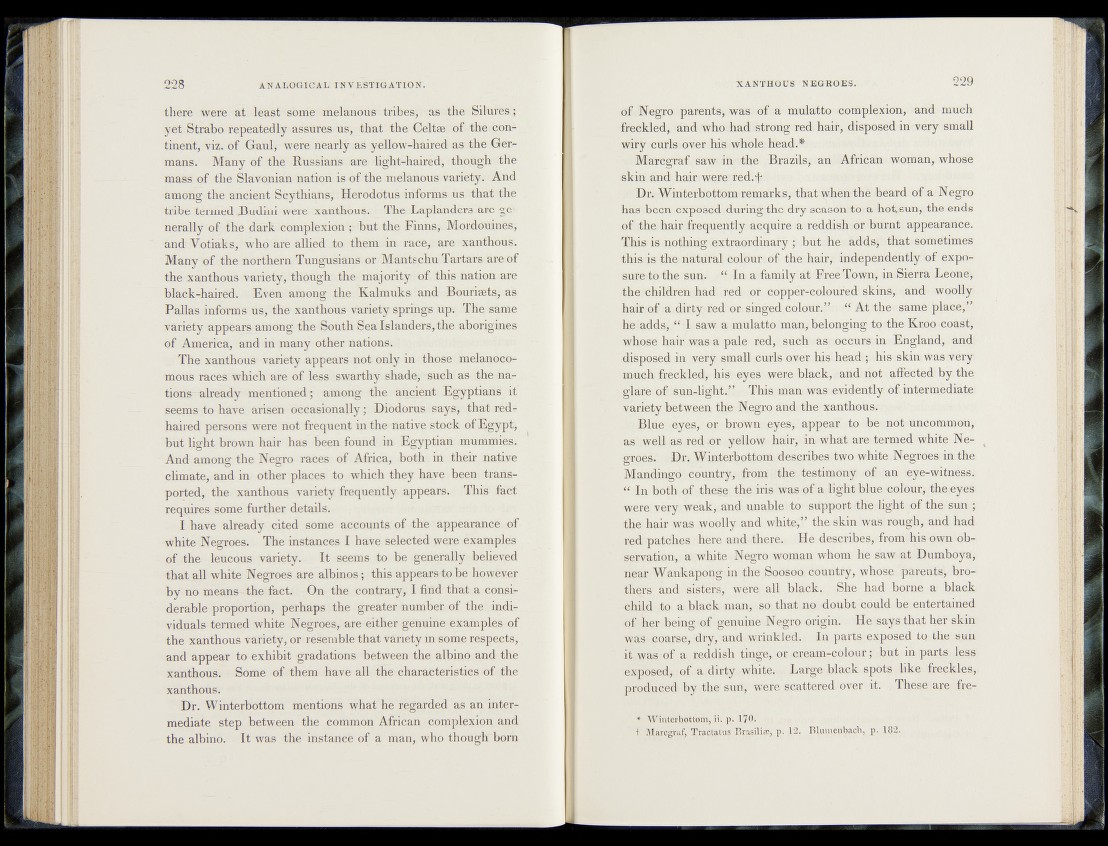
there were a t, least some' melanous" tribes,%, as the Si'luresq
yet Strabo repeatedly assures us, that the. Geltaa; of the com-
tinent, viz. of Gaul,- were nearly :as yellow-haired as the Gen-
mans. Many of the Russians are light-haired, through the
mass of the Slavonian nation is of the melanous variety . And
among the ancient Scythians, Herodotus informs us that the
tribe termed Jludini were xanthous. The Laplanders ate generally
of the derk complexion r but the Finns,.: Mordouim®Sj
and Votiaks, who are allied ito them in race, are xanthous.
Many of the northern Tungusians or Mantschu .Tartars are of
the xanthous variety, though the majority, o f this nation are
black-haired. Even among the Kalmuks and Bourisets, as
Pallas informs us, the xanthous variety springs up. The same
variety appears among the South Sea lslandersy the aboiigiKeS
of America, and in many other nations.
The xanthous variety appears not only in those melanbeo-
mous races which are of less swarthy shade, such as the nar
tiona" already mentioned; among the ancient Egyptians it
seems to have arisen, occasionally; Diodorus saysy that red-
haired persons were not frequent in the native stock .of Egypt,
but light brown hair has been found in Egyptian mummies.
And among the Negro races of Africa, both in their native
climate, and in other places to which they have been transported,
the xanthous variety frequently appears. This fact
requires some further details.
I have already cited some accounts of the appearance of
white Negroes. The instances I have selected were examples
of the leucous variety. I t seems to be generally believed
that all white Negroes are albinos; this appearsrto be however
by no means-the fact. On the contrary, I find that a considerable
proportion, perhaps the greater number of the individuals
termed white Negroes, are either genuine examples of
the xanthous variety, or resemble that variety in some respects,
and appear to exhibit gradations between the albino and the
xanthous. Some of them have all the characteristics of the
xanthous.
Dr. Winterbottom mentions what he regarded as an intermediate
step between the common African complexion and
the albino. It was the instance of a man, who though born
of iNegro parents, was. of a mulatto complexion, and much
freckled, and-who.had .Strorig red hair, disposed in very small
wily cuite oiler his whole;head.*
-> rMaregraf. sawrinM-ke /Brazils, an Africafr woman, whose
skin and hair ■ were1’red: $
, Dr.>Winterbottom;renaark.svthat; when the b e a rd o f :a-Negro
has been exposed .during; the dry se^senito^a» hot,sun, the ends 'V
of the hair frequently; ucquirefai'redflisfrbr brirnMiappearance.
Thisas mothing .extraordinary ; but hes>i.dds;‘ that,!sometimes'
this is the*natural feolbur of theihair;-- independently tof exposure
tb'thefsun. In a family .at Free Town, in Sierra -Leone,
the chil&re’njaad r©,dr- or eopperrooloufed skins, and woolly
hair of a dirty; tedl»or}'singed(OQ>lour; ji Atithe same p la c ed
hfeiadds, “ T. saw a mulatto,,! man, belonging-ito the Kr.00 coast,
wl|Qse haiR^waSi-a pale red, such rasKoccurs ln England, and
disposed in very small-curls over his! head■ hi s * skinwas very*
much- freck led hisi >pyes.jj| were black, ?and. not affected* byi the;
glare Qf s,nn-light.” This man was evidentlyrof intermediate,
variety between, the Negro and-the xanthous*^
, Blue 'ayes,‘ -or brown »eyes, appear ip be not uncommon,
a-S- .well ias.;t©d;s®r. yellow hair, .in what ara^ejaapdHwhite NeT |
groes/ - Dr. Winterbottom .describesdwo white Negroes- in the
Mandmgo; country,-from ' the-testimony: -of an j^fe^ydtnessi
“ In both; of these the iris‘was o,f ariight blue colour, -theeyes
were! very, weak,, and-unablel to support ithe light *6f the sun ; '
the hair was woolly and white,’’ the skin iwas'rougjk; and. had
red patches here and there. He describes,*- fromihis own observation,
a white Negro woman whorri;>he saw a t Dumboya,
near Wankapong in the Soosoo, country, whose, parents5,.brothers
and sisters, were all black. , She had borpe a black
child to a black man, so; that no doubt could be;entertained
of her being of genuine-Negro origin. He says that her skin
was coarse, dry, and wrinkled. In parts exposed to the-sun
it was of ,a reddish tinge, o^.creamrcolour; but in parts nless.
exposed, of a dirty white. Large black spotshke, freckles,
produced by the sun', were scattered over-it: j These are fre-
* Winterbottom, ii. p. 170.
+ Marcgraf, Tractatus Brasili3e,p . 12. Blumenbach, p. 182.